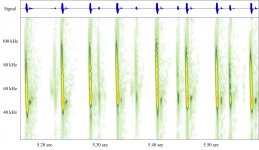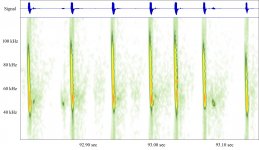BarryWarrington
New member
Hi,
New to bats so any help with these sonograms would be great. I was thinking possibly Natterer's but the frequency seems to stop at around 40kHz which is too high for Natterer's?
Considered Whiskered and Brandts but again, the frequency seems too high at the lower end of mine?
Only one in my book which could fit is Alcathoe but the higher end seems not high enough in my sonograms (plus it's quite rare?)!
Any help would be much appreciated as a newbie!
Thanks!
New to bats so any help with these sonograms would be great. I was thinking possibly Natterer's but the frequency seems to stop at around 40kHz which is too high for Natterer's?
Considered Whiskered and Brandts but again, the frequency seems too high at the lower end of mine?
Only one in my book which could fit is Alcathoe but the higher end seems not high enough in my sonograms (plus it's quite rare?)!
Any help would be much appreciated as a newbie!
Thanks!






